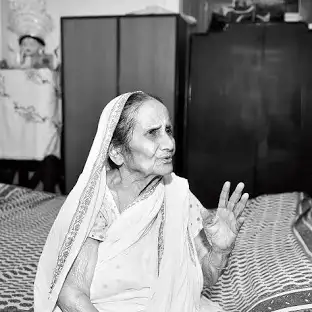
Rani Rashmoni
Rani Rashmoni stands as a towering figure in the history of Bengal, known for her unparalleled contributions to social welfare, religion, and the Indian freedom movement. Born in the early 19th century, she rose to prominence through her remarkable philanthropic activities and unwavering dedication to public service. Despite facing numerous societal challenges, her resilience and vision transformed the lives of countless individuals, particularly the marginalized sections of society.
Rani Rashmoni is perhaps best known for founding the Dakshineswar Kali Temple, a landmark that has become an iconic symbol of spiritual devotion and architectural beauty. However, her influence extended far beyond religious spheres. As a philanthropist, she established schools, ghats, and roads, significantly enhancing the infrastructure and educational landscape of Bengal. Her commitment to women’s education and social reform set a precedent during a time when such initiatives were scarcely undertaken.
In addition to her philanthropic endeavors, Rani Rashmoni played a vital role in the Indian freedom movement. She supported various anti-British activities and offered refuge to prominent freedom fighters, thus cementing her place in the annals of India’s struggle for independence. Her legacy is celebrated for its multifaceted contributions, spanning social, religious, and political domains.
Early Life
Rani Rashmoni was born on September 28, 1793, in the small village of Kona, located in the present-day North 24 Parganas district of West Bengal. She was born into a humble family belonging to the Mahishya caste, a class of cultivators, which instilled in her a deep connection with the rural and agrarian lifestyle. Her birth name was Rani Rashmoni Das, and her early years were marked by simplicity and modesty.
Despite the limitations of her social standing, Rashmoni exhibited remarkable intelligence and a keen sense of curiosity from a young age. Education for girls was a rare privilege in her time, especially for those from non-elite backgrounds. However, Rashmoni’s inherent sharpness and quick learning ability allowed her to acquire basic literacy and numeracy skills, which later played a significant role in her management of vast estates and philanthropic endeavors.
Her early life was also shaped by the values of compassion, resilience, and determination, which were imparted by her parents. Growing up, Rashmoni witnessed the hardships faced by the common people, particularly women, in her community. These observations left a lasting impression on her and sowed the seeds of her lifelong commitment to social justice and upliftment.
At a young age, she was married to Raj Chandra Das, a wealthy zamindar (landowner) of Janbazar in Kolkata. This marriage marked a turning point in her life, catapulting her from the rustic environs of Kona to the bustling metropolis of Kolkata. Despite her initial apprehensions, Rashmoni adapted quickly to her new role, displaying an extraordinary acumen for estate management and a deep empathy for the people under her care.
This transition from a village girl to the mistress of a vast estate provided Rashmoni with the resources and platform needed to pursue her philanthropic and social reform initiatives. Her early life, characterized by modest beginnings and profound personal growth, laid the foundation for the remarkable contributions she would make in the years to come.
Marriage and Family
Rani Rashmoni’s marriage to Raj Chandra Das, a prosperous zamindar of Janbazar in Kolkata, significantly influenced her trajectory and expanded her influence. Married at a young age, Rashmoni moved from the rustic village of Kona to the bustling urban landscape of Kolkata. This union not only elevated her social status but also provided her with the means and opportunities to make a lasting impact on society.
Raj Chandra Das was known for his progressive outlook and supportive nature. He recognized Rashmoni’s intelligence and capabilities and encouraged her active participation in the management of their vast estates. Rashmoni, with her natural acumen and keen insight, quickly mastered the complexities of estate management, proving herself to be an able administrator. Her involvement in these affairs earned her respect and admiration from both her family and the local community.
The couple had four daughters: Padmamani, Kumari, Karunamoyee, and Jagadamba. Rashmoni’s role as a mother was marked by her deep affection and unwavering commitment to their upbringing. She ensured that her daughters received a well-rounded education, a rare privilege for women at the time, thereby laying the foundation for their future roles in society. Rashmoni’s emphasis on education and empowerment for her daughters reflected her broader vision of social reform and gender equality.
Rashmoni’s family life was deeply intertwined with her philanthropic activities. Alongside her husband, she undertook numerous social and charitable projects, addressing the needs of the poor and marginalized. The Das family was known for their generous donations to temples, schools, and other community welfare initiatives. Raj Chandra Das’s untimely death in 1836 left Rashmoni to shoulder the responsibility of managing the estate and continuing their shared mission of philanthropy.
Despite the challenges of widowhood, Rashmoni displayed remarkable resilience and leadership. She not only maintained the family’s financial stability but also expanded their philanthropic endeavors. Her ability to balance her roles as a mother, estate manager, and social reformer earned her immense respect and admiration.
Rani Rashmoni’s marriage to Raj Chandra Das was a partnership of mutual respect and shared vision. Together, they laid the groundwork for the social and religious contributions that would define Rashmoni’s legacy. Her family life, characterized by love, support, and collaboration, played a crucial role in shaping her journey as a pioneering philanthropist and reformer.
Philanthropy and Social Reforms
Rani Rashmoni’s legacy as a philanthropist and social reformer is marked by her relentless dedication to improving the lives of the underprivileged and marginalized. Her philanthropic activities were driven by a profound sense of empathy and a vision for social justice, which led her to undertake numerous initiatives aimed at uplifting the downtrodden and addressing societal inequalities.
One of Rani Rashmoni’s most notable contributions was the establishment of educational institutions. Recognizing the transformative power of education, she founded several schools, particularly focusing on women’s education at a time when it was largely neglected. By promoting literacy and learning among women, Rashmoni aimed to empower them with the tools necessary for self-reliance and personal growth. These schools provided a safe and nurturing environment for girls to receive an education, laying the groundwork for greater gender equality in Bengal.
In addition to her focus on education, Rani Rashmoni was deeply committed to improving public infrastructure. She invested substantial resources in the construction of roads, ghats (riverfront steps), and water supply systems. One of her significant contributions was the construction of the Babughat and Ahiritola Ghat in Kolkata, which facilitated better access to the Ganges River for the local population. These ghats not only improved transportation and commerce but also provided essential public amenities for bathing and other daily activities.
Rani Rashmoni’s philanthropy extended to healthcare as well. She established charitable dispensaries and provided financial support to hospitals, ensuring that medical care was accessible to the poor and needy. Her efforts to improve public health and sanitation had a lasting impact on the communities she served, contributing to overall well-being and quality of life.
Her commitment to social reform was also evident in her support for widow remarriage and opposition to the oppressive practices faced by widows in traditional society. Rani Rashmoni’s progressive views and actions challenged the entrenched social norms of her time, advocating for a more humane and equitable treatment of women.
Beyond her material contributions, Rani Rashmoni was known for her personal involvement in addressing the needs of her community. She would often personally distribute food and clothing to the poor, providing immediate relief to those in distress. Her hands-on approach to philanthropy and her direct engagement with the people earned her immense respect and affection.
Rani Rashmoni’s philanthropic and social reform initiatives were groundbreaking for their time. Her visionary leadership and compassionate actions addressed some of the most pressing issues of her society, from education and healthcare to infrastructure and social justice. Through her unwavering commitment to the welfare of others, she left an indelible mark on Bengal, inspiring future generations to continue her legacy of service and reform.
Religious Contributions
Rani Rashmoni’s contributions to the religious and spiritual life of Bengal are monumental, with the founding of the Dakshineswar Kali Temple being her most notable achievement. Her deep devotion to Hinduism and her desire to create a spiritual haven for worshippers led her to undertake this ambitious project, which has since become a significant cultural and religious landmark.
The inspiration for the Dakshineswar Kali Temple came to Rani Rashmoni in a dream, where the goddess Kali instructed her to build a temple dedicated to her worship. Moved by this divine vision, Rashmoni purchased a large plot of land along the eastern bank of the Hooghly River in Dakshineswar, near Kolkata. The construction of the temple complex began in 1847 and was completed in 1855, a testament to her unwavering commitment and meticulous planning.
The temple complex, which covers 25 acres, includes the main temple dedicated to Goddess Kali, along with temples dedicated to Lord Shiva and Radha-Krishna. The architectural grandeur of the Dakshineswar Kali Temple, with its distinctive nine spires, reflects Rashmoni’s vision of creating a sacred space that was both majestic and accessible to all devotees. The temple’s construction was overseen by renowned architects and artisans, ensuring its structural and aesthetic excellence.
Rani Rashmoni’s establishment of the temple went beyond mere architectural achievement; it was a profound act of social and religious inclusivity. Unlike many temples of her time, which were often restricted to certain castes, the Dakshineswar Kali Temple was open to people of all castes and backgrounds. This inclusive approach challenged the prevailing social norms and emphasized the universal nature of spiritual worship.
One of the most significant spiritual figures associated with the Dakshineswar Kali Temple was Sri Ramakrishna Paramahamsa, who served as the temple’s head priest from 1855 until his death in 1886. Under his guidance, the temple became a center for spiritual teaching and religious discourse. Rani Rashmoni’s support for Sri Ramakrishna and her provision of a conducive environment for his spiritual practices played a crucial role in the development of his teachings, which have had a profound influence on Hindu philosophy and spirituality.
In addition to the temple, Rani Rashmoni also supported various religious festivals and rituals, ensuring that these events were celebrated with great fervor and devotion. Her patronage extended to other religious sites and institutions, reflecting her deep commitment to fostering spiritual growth and religious harmony.
Rani Rashmoni’s religious contributions, particularly the founding of the Dakshineswar Kali Temple, have left an enduring legacy in Bengal’s spiritual landscape. Her efforts to create a space for inclusive worship and her support for prominent spiritual leaders like Sri Ramakrishna have had a lasting impact on Hinduism and continue to inspire devotees around the world. Through her devotion and visionary leadership, Rani Rashmoni exemplified the profound connection between faith, social service, and community upliftment.
Role in the Indian Freedom Movement
Though primarily known for her philanthropic and religious contributions, Rani Rashmoni also played a significant, albeit less publicized, role in the Indian freedom movement. Her involvement in anti-British activities and support for contemporary freedom fighters demonstrated her commitment to India’s struggle for independence.
Rani Rashmoni lived during a period when British colonial rule was tightening its grip on India, causing widespread economic and social distress. As a prominent zamindar, she was acutely aware of the injustices and exploitation faced by her people. Her actions reflected a subtle yet profound resistance to colonial oppression, often leveraging her social and economic influence to support the cause of independence.
One of Rani Rashmoni’s notable contributions to the freedom movement was her financial support for various nationalist activities. She discreetly funded revolutionary groups and provided resources that were crucial for their operations. Her wealth and influence enabled her to assist in the procurement of supplies and the organization of covert meetings, thereby facilitating the efforts of freedom fighters who were actively working to undermine British rule.
Rani Rashmoni’s residence in Janbazar, Kolkata, served as a haven for many revolutionaries. She offered refuge to prominent leaders and activists, providing them with a safe space to strategize and plan their actions against the British authorities. This support was invaluable during a time when such activities were fraught with danger and required considerable courage and discretion.
Beyond her direct support for revolutionary activities, Rani Rashmoni also used her position to advocate for the rights of her people against colonial policies. She was known to resist unjust taxes and oppressive measures imposed by the British administration. Her defiance was a source of inspiration for her contemporaries, demonstrating that resistance could take many forms, from direct confrontation to strategic support and advocacy.
Rani Rashmoni’s commitment to social justice and her opposition to colonial exploitation were also evident in her interactions with British officials. She was known for her forthrightness and willingness to challenge unfair practices. Her assertiveness in defending the rights and dignity of her people often put her at odds with the colonial authorities, showcasing her fearless spirit and unwavering dedication to justice.
While her contributions to the freedom movement might not be as widely recognized as those of some of her contemporaries, Rani Rashmoni’s role was nonetheless significant. Her support for revolutionary activities, her advocacy for the rights of the oppressed, and her willingness to stand up against colonial exploitation all contributed to the broader struggle for India’s independence.
Rani Rashmoni’s involvement in the Indian freedom movement highlights her multifaceted legacy. She was not only a philanthropist and religious benefactor but also a patriot who quietly yet effectively supported the fight against British colonial rule. Her actions during this critical period underscore her deep commitment to the well-being and liberation of her people, further cementing her place as a revered figure in India’s history.
Economic and Civic Contributions
Rani Rashmoni’s contributions to economic and civic development were substantial and transformative for her time. As a visionary leader and philanthropist, she played a pivotal role in enhancing the infrastructure and commercial landscape of Kolkata and its surrounding areas.
One of her most notable contributions was the construction of roads and ghats (riverfront steps) which facilitated better connectivity and transport. The construction of the Babu Ghat on the Hooghly River stands as a testament to her commitment to civic development. This ghat not only served as a key point for bathing and religious activities but also became an essential hub for commerce and transportation, boosting the local economy.
In addition to infrastructure, Rani Rashmoni made significant investments in the development of marketplaces and trade facilities. She recognized the importance of commerce for the prosperity of her community and worked tirelessly to create environments where trade could flourish. Her initiatives helped improve the economic conditions of local traders and merchants, fostering a more vibrant and dynamic economic environment.
Moreover, Rani Rashmoni’s involvement in the development of civic amenities extended to public health and sanitation. She funded the construction of numerous public wells and water bodies, addressing the critical need for clean drinking water in her community. These contributions not only improved public health but also enhanced the overall quality of life for the residents.
Her foresight and dedication to civic duties also included support for various public works projects that benefitted the larger population. These projects included the maintenance and enhancement of existing infrastructures, ensuring they met the growing needs of the city.
Rani Rashmoni’s economic and civic contributions were driven by her deep sense of responsibility towards her people. Her initiatives laid the groundwork for future developments and demonstrated how visionary leadership could bring about significant positive change in society. Her legacy in these areas continues to be remembered and celebrated, highlighting her enduring impact on the economic and civic fabric of Kolkata.
Challenges and Controversies
Rani Rashmoni’s remarkable contributions to society were not without their challenges and controversies. Despite her noble intentions and significant achievements, she faced considerable opposition and criticism from various quarters.
One of the primary challenges she encountered was resistance from the conservative segments of society. Her efforts to promote women’s education and social welfare were groundbreaking at a time when such ideas were not widely accepted. Many traditionalists viewed her initiatives as a threat to the established social order, leading to significant pushback. Rani Rashmoni had to navigate this resistance carefully, balancing her progressive vision with the need to maintain social harmony.
Additionally, her philanthropic activities and large-scale public works often drew skepticism and criticism from her contemporaries. Some accused her of using her wealth and influence to gain personal glory and political leverage. These criticisms, however, did not deter her from continuing her charitable work and contributions to society. Rani Rashmoni remained steadfast in her commitment to the welfare of her people, demonstrating resilience in the face of adversity.
Her involvement in the construction of the Dakshineswar Kali Temple also sparked controversies. The temple, now a significant religious landmark, faced opposition from orthodox Brahmins who initially refused to consecrate the idol, questioning the propriety of a lower-caste woman like Rashmoni establishing a major temple. Overcoming these social prejudices, Rani Rashmoni persisted, eventually securing the support of revered spiritual leaders, which helped legitimize the temple and its practices.
Rani Rashmoni’s support for anti-British activities also invited scrutiny from the colonial authorities. Her financial backing of initiatives and individuals involved in the Indian freedom movement was seen as a challenge to British rule, leading to surveillance and suspicion. Balancing her philanthropic endeavors with political activism required astute judgment and a willingness to accept the risks involved.
Moreover, her personal life was not free from controversy. The management of her vast estates and wealth after her husband’s death brought about familial disputes and legal battles. Her decision to appoint Mathur Mohan Biswas, a trusted confidant and relative, to oversee her affairs, was met with disapproval by some family members, leading to internal conflicts.
Legacy and Impact
Rani Rashmoni’s legacy is both profound and enduring, reflecting her significant contributions to social, religious, and civic life in India. Her impact is evident in various facets of society, and her memory is honored and celebrated in numerous ways.
One of the most enduring symbols of her legacy is the Dakshineswar Kali Temple. This temple remains a major pilgrimage site, attracting millions of devotees each year. The temple not only stands as a testament to her devotion and piety but also as a symbol of her efforts to make religious practices more inclusive and accessible. The temple’s association with Sri Ramakrishna Paramahamsa, one of India’s most revered spiritual figures, further elevates its significance. Sri Ramakrishna’s association with the temple has drawn countless followers, linking Rani Rashmoni’s name with the broader spiritual heritage of India.
Rani Rashmoni’s contributions to education and social welfare continue to be recognized and built upon. The schools and charitable institutions she established laid the groundwork for future educational and social reforms, particularly for women. Her pioneering efforts in promoting women’s education have inspired subsequent generations to continue advocating for gender equality and educational opportunities for all.
In the realm of civic contributions, the infrastructure projects she initiated, such as the construction of roads, ghats, and public wells, have had a lasting impact on the urban development of Kolkata. Babu Ghat, in particular, remains a prominent landmark, serving both practical and ceremonial purposes for the city’s residents. Her vision for improving public amenities has been carried forward by city planners and administrators who continue to build on her legacy of civic improvement.
Rani Rashmoni’s support for the Indian freedom movement, although less documented, played a role in inspiring future generations of freedom fighters. Her willingness to challenge British authority and support nationalist causes demonstrated her patriotism and commitment to India’s independence.
The commemoration of Rani Rashmoni in modern times includes the naming of streets, institutions, and awards after her. These honors serve as a reminder of her contributions and keep her memory alive in the public consciousness. Statues and memorials erected in her honor further solidify her place in history, ensuring that her legacy is recognized and appreciated by future generations.
In addition to these tangible reminders, Rani Rashmoni’s life story serves as an inspiration to many. Her resilience in the face of opposition, her dedication to social causes, and her ability to effect change despite significant challenges continue to inspire social activists, philanthropists, and leaders.
Rani Rashmoni’s impact on society is a testament to her visionary leadership and unwavering commitment to the welfare of her people. Her legacy is a rich tapestry of religious devotion, social reform, and civic improvement, making her an enduring figure in the history of India.
Conclusion
Rani Rashmoni stands as an unsung hero in the annals of Indian history, her legacy often overshadowed by more prominent figures. However, her contributions to social reform, education, religion, and civic development are no less significant. Through her unwavering commitment to the welfare of her community and her bold vision for societal change, she carved out a unique and impactful role that deserves recognition and celebration.
Her life’s work transcends the conventional roles expected of women in her time, showcasing her extraordinary leadership and philanthropic spirit. Despite facing significant opposition and societal constraints, Rani Rashmoni’s initiatives in building schools, establishing charitable institutions, and promoting women’s education were revolutionary. Her dedication to these causes laid the foundation for future social reforms, particularly in the realm of women’s rights and education.
The construction of the Dakshineswar Kali Temple is a hallmark of her religious contributions, reflecting her deep spirituality and inclusive approach to worship. This temple, which became a spiritual hub under the guidance of Sri Ramakrishna Paramahamsa, remains a beacon of religious devotion and cultural heritage.
Rani Rashmoni’s economic and civic contributions, such as the development of infrastructure and public amenities, significantly improved the quality of life in her community. Her efforts in constructing roads, ghats, and wells facilitated trade, commerce, and daily living, demonstrating her foresight and commitment to civic welfare.
Her support for the Indian freedom movement, though less documented, highlights her patriotism and courage in challenging colonial rule. By backing anti-British activities, she aligned herself with the broader struggle for India’s independence, further cementing her role as a national heroine.
Rani Rashmoni’s ability to overcome numerous challenges and controversies, from societal resistance to family disputes, underscores her resilience and strategic acumen. Her life story, marked by perseverance and an indomitable spirit, serves as an inspiring example for future generations.
In recognizing Rani Rashmoni as an unsung hero, it is essential to acknowledge the profound impact of her contributions. Her legacy is a testament to the power of individual initiative and the lasting change it can bring about in society. Rani Rashmoni’s story deserves to be told and celebrated, ensuring that her remarkable achievements are remembered and honored. Through her pioneering efforts, she has secured a place in history as a true visionary and a benevolent force for change, inspiring others to follow in her footsteps and strive for a more just and equitable society.
By: Soumya Ghosh
Write and Win: Participate in Creative writing Contest & International Essay Contest and win fabulous prizes.


